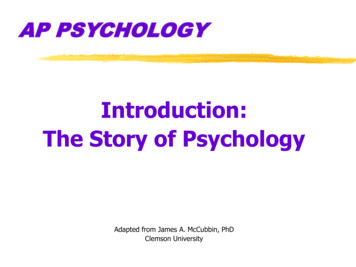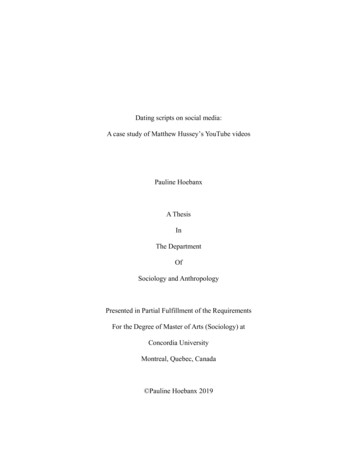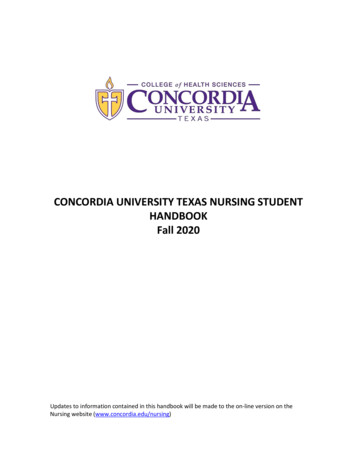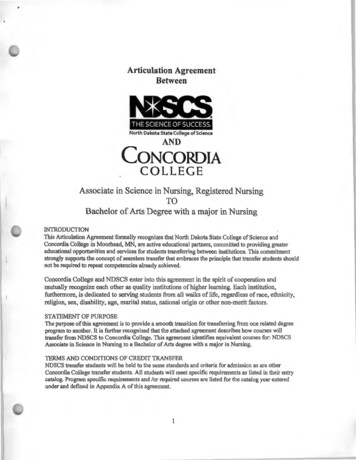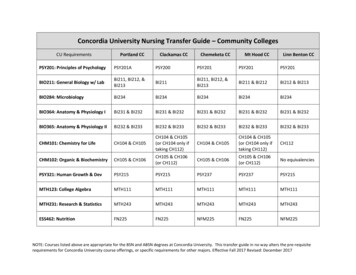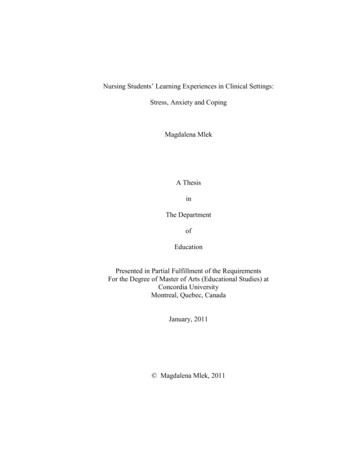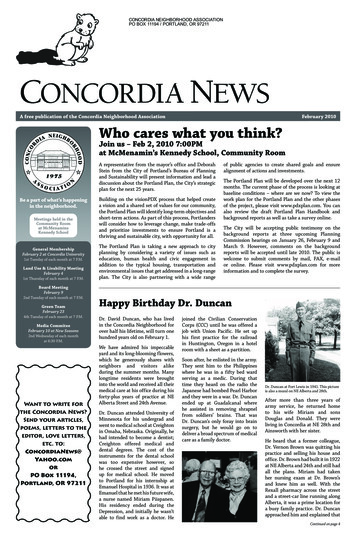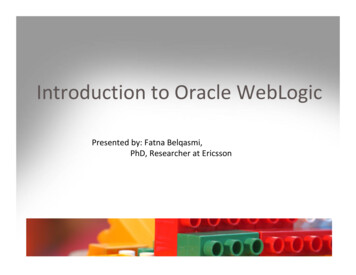
Transcription
Introduction to Oracle WebLogicPresented by: Fatna Belqasmi,PhD, Researcher at Ericsson
Agenda Overview Download and installation A concrete scenario using the real product Hints for the project
Overview Oracle WebLogic WebServer Oracle Workshop forWebLogic
Oracle WebLogic Web Server Is a Java Enterprise Edition (Java EE) application server Supports the deployment of many types of distributed applications Provides a standard set of APIs for creating distributed Java applicationsthat can access a wide variety of services–––––Web ServicesWeb applications (HTML, Java ServerPages-JSP, .)Remote Method Invocation (RMI)Java Database Connectivity (JDBC) .
Oracle WebLogic Web Server WebLogic Server 10.3 supports two types of Web Service APIs– Java API for XML based Remote Procedure Call (JAX-RPC) Defines the Java APIs for making XML-based remote procedure calls(RPC)– Java API for XML based Web Services (JAX-WS) Is a standards-based API for coding, assembling, and deploying JavaWeb Services Is the successor to the JAX-RPC
Oracle WebLogic Web Server WebLogic Server 10.3 supports the following Web Servicestandards–––––––––JAX-WS 2.1JAX-RPC 1.1Web Services for Java EE 1.2Web Services Metadata for the Java Platform 2.0 (JSR-181)Web Services Description Language (WSDL) 1.1Simple Object Access Protocol (SOAP) 1.1 and 1.2Web Services Security (WS-Security) 1.1Universal Description, Discovery, and Integration (UDDI) 2.0
Oracle Workshop for WebLogic Is a set of plug-ins to the Eclipse Integrated Development Environment (IDE)platform– Many of the standard features of the workshop are described in the Eclipsedocumentation, available at http://eclipse.org Allows quick and easy creation, deployment and testing of enterpriseapplications:––––Web ServicesJavaWeb Applications The applications can be deployed on a wide variety of servers, including– WebLogic Server– Tomcat,– JBoss, and others
Download and installation Download– Free download with are/products/ias/bea main.html– Accept the license agreement on the top of the page– Click the link: “Oracle Workshop for WebLogic 10.3 - Package Installer” OR “Oracle Workshop for WebLogic 10.3 - Net Installer”– Sign in or register if you are new Installation– Double click the downloaded file and follow the instructions ebservices.html
A Concrete Scenario Using the RealProduct
A Concrete Scenario A simple “Hello World” web service– Create a Web Service Create projectCreate packageCreate a Web ServiceAdd a web service method– Add/start weblogic server Create a domain Start server– Deploy and test the Web Service Run on server Web logic test client– See SOAP, WSDL
A Concrete Scenario Create a project
A Concrete Scenario Create a project
A Concrete Scenario Create a project
A Concrete Scenario Create a new package
A Concrete Scenario Create a new package
A Concrete Scenario Create a Web Service– Specify the namesand parameters of allof the service’sexposed operations Steps– Create a WebLogicWS– Add the methods– Configure themethods’ parameters
A Concrete Scenario Create a Web Service
A Concrete Scenario Create a Web Service
A Concrete Scenario Create a Web Service
A Concrete Scenario Create a Web Service
A Concrete Scenario Add the WebService code– Implement thebusiness logic ofyour Web Service Using both theDesign andSource Views Programminglanguage– Java
A Concrete Scenario Add a weblogic server
A Concrete Scenario Start the weblogic server
A Concrete Scenario Deploy a Web Service
A Concrete Scenario Test a WebService– Using Test View Test View– Invoke a webservice methodfrom a browser– View the XMLmessages that areexchanged
A Concrete Scenario– View the WSDL file
Hints for the project
What to implement?Application GUIstartClientClientClientConference ()
Hints for the project Server side:– a conferencing web service that implements asimplified conference focus uses SIP stack to listen to, receive, process andsend SIP messages– Use JAIN SIP Client side: SIP client– Download or– Code your client using SIP stack Use of JMF for media
How to download JAIN SIP JSR 32 Jain SIP API doc and .jar can be downloaded at:– 032/index.html– Unzip Reference implementation .jar can be downloaded at:– ightly/– Click: “jain-sip-ri/”, you can find all nightly build implementations .jar– You can also find sdp implementations there When implementing a web service using Jain SIP, put the two jar files (oneapi, one impl) into your project: \WEB-INF\lib– jsip api v1.2.jar– jain-sip-ri-1.2.xx.jar Tip: you may need log4j-xxx.jar if you always have running errors when using JainSIP (this depends on which sip impl that you g/log4j/1.2.15/apache-log4j-1.2.15.zip
A brief introduction to JAIN SIP JAIN-SIP is a java-standard interface to a SIP signaling stack It provides a low level Java API specification for SIP Signaling It was designed for the developers who require fine grained access to theSIP protocol It can be used in:– Clients– Servers– Proxies JAIN SIP reference implementation is open source, very stable, and verywidely used Introduction to JAIN s/dev2arch/2007/10/introduction-jain-sip.html
A brief introduction to JAIN SIP JAIN SIP services– Provides methods to format and send SIP messages– Parses incoming messages and enable the application to access themessages’ fields via a standardized JAVA interface– Invokes appropriate application handlers when appropriate (messagearrivals, transaction time-outs)– Provide Transaction support and manage Transaction state and lifetimeon behalf of a user application.– Provide Dialog support and manage Dialog state and lifetime on behalfon a user application33
JAIN SIP ArchitectureApplicationListenerSIP MessagesListenerSIP EventsSIP MessagesProviderProviderListening PointListening PointStackStackNetwork34SIP Events JavaOne 2003 Session #1024
A brief introduction to JAIN SIP
A brief introduction to JAIN SIPBasic steps:1.2.3.4.5.6.public class MySipListener implements javax.sip.SipListener { }SipFactory sipFactory SipFactory.getInstance();SipStack sipStack nt listeningPoint sipStack.createListeningPoint(address, port,transport);SipProvider sipProvider ider.addSipListener(mySipListener); Introduction to JAIN s/dev2arch/2007/10/introduction-jain-sip.html
SDS or Web Logic ? Ericsson SDS:– Need to configure IMS first Oracle Web Logic– No configuration is needed– Can use SIP Servlet– Can use SIP Stack (lower level of– Trigger: from SIP client orHTTP Servlet– Trigger: from web logic test clientor any web service that talksSOAP Both need programming– Conference clientregistration: register to CSCFabstraction than SIP Servlet) The first option is provided by thetool, no need to code– Conference client registration:register to your SIP Listener (inyour WS logic) What’s in common:– Media handling: RTP/RTCP (JMF)– Conference client: SIP client that talks RTP
References http://download.oracle.com/docs/cd/E12840 01/wls/docs103/intro/chap1.html http://download.oracle.com/docs/cd/E12840 01/wls/docs103/webserv intro/overview.html#choose http://download.oracle.com/docs/cd/E12840 01/wls/docs103/webserv intro/standards.html#wp1078494 /index.html http://e-docs.bea.com/wlw/docs103/index.html http://e-docs.bea.com/wls/docs103/webservices.html arch/2007/10/introduction-jainsip.html
Q&A
“Oracle Workshop for WebLogic10.3 -Package Installer . Listening Point Listening Point Listener. A brief introduction to JAIN SIP. A brief introduction to JAIN SIP Basic steps: 1. publicclass MySipListener implements javax.sip.SipListener{ } 2. SipFactorysipFactory SipFactory.getInstance (); 3. SipStacksipStack sipFactory.createSipStack(properties); 4. ListeningPointlisteningPoint .


